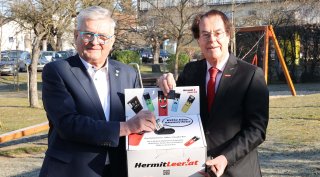
Correctly disposed-of batteries essential to recycled raw materials and safety
Waste separation as a success factor. E-bikes, robot vacuum cleaners, kitchen scales, drones, e-scooters, jukeboxes, tablets, musical greeting cards, cordless drills, robot lawnmowers and, last but not least, smartphones – all these devices can only be operated with the aid of batteries. Some 6139 tonnes of device batteries were sold in 2021, with the proportion of lithium-ion batteries continuing to increase, at 45 per cent. Although Austria is meeting the collection rate for waste device batteries set by the EU, 45 per cent, some 850 tonnes of device batteries still end up in residual waste and can no longer be recycled. The lack of proper waste separation means a loss of valuable raw materials such as aluminium, nickel, manganese, cobalt and copper, all of which were previously extracted outside Europe and processed with high energy input. In addition, every Austrian household holds on to at least eight electrical or electronic devices that are no longer in use.
Wolfgang Neubauer, Chairman of the umbrella organisation of Styrian waste management associations, confirms this: ‘If we collect batteries separately, they get recycled. The problem with many products is that you can’t remove the battery, with all of the problems that brings.’ Many lithium-ion batteries are now installed in devices ‘invisibly’ and some people are just not aware that their flashing trainers, e-cigarettes, children’s toys and other products are devices that can only be properly disposed of at waste collection centres or, alternatively, returned to where they were bought if the battery can be removed, to keep them in the materials cycle.
A key factor in support of proper waste separation is the risk of fire posed by damaged lithium-ion batteries. ‘Analyses suggest that one tonne of residual waste in Austria contains around 20 batteries, of which at least one will be a lithium-ion battery, and of those around 30 per cent have a state of charge that could cause a fire. Extrapolated, that means around 50,000 potential sources of ignition in Styrian waste every year,’ explains Christian Schreyer, Managing Director of the umbrella association of Styrian waste associations of the safety aspect that concerns employees, and the infrastructure, of waste collection centres.
Alfred Riedl, President of the Austrian Association of Local Authorities, makes an appeal: ‘Our joint task has to be to make people more aware of the importance of proper waste separation by leading by example and supplying detailed information and communication. That way, we can not only reduce costs, but also support circularity, limit fire hazards and use resources sensibly.’

The myth of the circular economy. Many people are of the belief that the circular economy cannot be accomplished and that things like lithium-ion batteries from e-mobility cannot be recycled. Saubermacher has been able to prove that this is a misconception with its two special recycling plants in Germany. With alkali-manganese batteries, the environmental pioneer has been able to achieve a recycling rate of around 90 per cent, and with lithium-ion batteries, a metal recovery rate of over 95 per cent. Important preliminary work, including the sorting of small domestic batteries, takes place at two Styrian locations. Unfortunately, incorrect items, and sometimes dangerous items like syringes, find their way into battery collection boxes placed in shops. Lithium-ion batteries from e-mobility are discharged, disassembled and prepared for recycling in Premstätten.
Saubermacher founder Hans Roth has concerns about the EU’s planned target for battery collection: ‘The collection rate for device batteries of 45 per cent will be increased to 65 per cent in 2025 and then to 70 per cent in 2030. The challenge over the next few years will be to introduce educational work to encourage people to dispose of old batteries with more thought. Only that way will it be possible to recover valuable contents and process them into recycled raw materials.’ The proposed EU Battery Regulation sets out compulsory recovery rates at element level, as well as the compulsory use of recycled raw materials. ‘Saubermacher is making preparations for increased battery quantities in order to continue to offer sustainable security of disposal for our customers,’ explains Roth.
press release
Contact
For press inquiries please contact:



